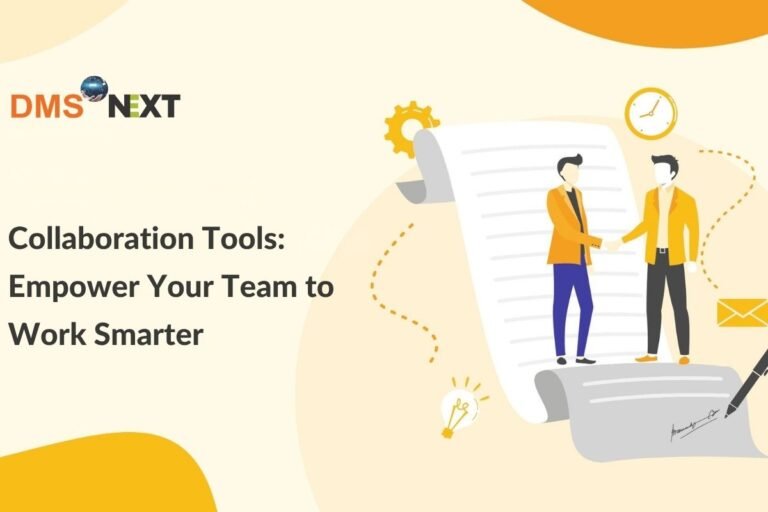
Introduction
Effective Cooperation is the backbone of every successful business. With distributed brigades and remote work getting the norm, having the right collaboration tools is critical. These tools enable flawless communication, document sharing, and design operation, icing brigades stay productive and aligned.
At EDMS Next, we offer advanced collaboration tools integrated with secure cloud storage and workflow automation, helping your team work smarter and faster.
In moment’s digital-first world, cooperation no longer depends on physical propinquity. brigades work across metropolises, time zones, and indeed mainlands. This is where collaboration tools come in software designed to help people communicate, partake information, and work together effectively, no matter where they are.
Collaboration tools are platforms that make it easier for brigades to plan systems, share lines, assign tasks, track progress, and exchange ideas in real time. Whether your platoon works ever or in an office, these tools are the backbone of effective and transparent collaboration.
In a ultramodern Document Management System( DMS), collaboration tools are n’t just addons they’re essential for streamlining communication, document sharing, and cooperation across departments.
Then are the crucial collaboration features that enhance productivity and secure document workflows
1. Real- Time Document Editing :
Collaboration tools in a DMS allow multiple druggies to edit the same document contemporaneously.
Example : Google Workspace style editing in an enterprise DMS platform.
2. Version Control & Audit Trails :
Every document change is automatically tracked with details like who edited, when, and what changed.
3. part- Grounded Access Control( RBAC) :
Not all collaborators need the same position of access.A DMS with collaboration features lets admins assign view, edit, comment, or share warrants grounded on places.
Benefit : Protects sensitive data while still enabling cooperation.
4. opining & Reflections :
Druggies can add inline commentary, notes, or highlights directly on documents.
5. Secure train participating & External Collaboration :
Advanced DMS platforms include secure sharing options for both internal brigades and external guests or merchandisers.
6. Integrated Communication Tools :
Some DMS results integrate converse, videotape, or comment vestments directly into the document workspace.
7. Task & Workflow robotization :
Collaboration features extend beyond communication DMS systems frequently include automated task assignment and workflow routing.
8. pall Availability & Remote Collaboration :
A pall- grounded DMS ensures that brigades can pierce, partake, and edit documents anytime, anywhere.
9. Integration with Other Business Tools :
ultramodern DMS results integrate seamlessly with CRM, ERP, dispatch, and design operation platforms.
10. announcements & exertion Alerts :
Real- time cautions inform druggies about document updates, commentary, blessings, or interpretation changes.
Advantage : Keeps everyone in the circle and ensures timely responses during platoon systems.
Learn more about EDMS Next Collaboration Tools to boost team productivity.
Collaboration tools are essential in modern workplaces because they:
With EDMS Next, all collaboration happens in a secure, cloud-based environment.



1. Streamlined Communication :
Centralized messaging, announcements, and videotape conferencing keep brigades aligned and reduce dispatch load.
2. Real- Time Collaboration :
Multiple platoon members can work on the same documents or systems contemporaneously with changes tracked automatically.
3. Bettered Productivity :
Task operation, monuments, and progress shadowing keep systems on schedule.
4. Enhanced Security :
Integrating collaboration with EDMS Next secure pall storehouse ensures data is defended while participated among brigades.
EDMS Next Collaboration Tools streamline these processes, keeping your team organized and productive
Collaboration tools can transfigure how brigades work but only if they’re used strategically.
Whether you’re managing systems, participating documents, or coordinating across departments, following stylish practices ensures that your collaboration platform delivers maximum productivity, security, and engagement.
Then are the top stylish practices for using collaboration tools effectively particularly within a Document Management System (DMS) terrain 👇
Before brigades begin uniting, define who can view, edit, or authorize documents.
Use role-based access control (RBAC) to help unauthorized data access.
Limit edit warrants to applicable contributors.
Benefit: Reduces confusion, ensures responsibility, and strengthens document security.
A harmonious file structure prevents versioning crimes and helps platoon members detect documents snappily.
Example:
✅ Marketing_CampaignPlan_May2025.docx
❌ final-final-draft.docx
Always keep version history enabled in your DMS or collaboration tool.
Advantage: Promotes transparency and ensures compliance with document integrity programs.
Real-time co-editing boosts cooperation but can produce chaos if unmanaged.
Goal: Maintain order while benefiting from live collaboration.
Centralize communication within your collaboration platform.
Result: Streamlined communication and faster decision-making.
Most modern DMS or collaboration platforms allow workflow automation.
Benefit: Saves time and reduces manual tracking errors.
EDMS Next combines collaboration tools with workflow automation to enhance team efficiency.
Collaboration tools are essential for modern businesses to enhance teamwork, improve productivity, and maintain secure communication. By integrating secure document storage, workflow automation, and real-time communication, teams can work efficiently and stay organized.
Visit EDMS Next to explore our collaboration tools, designed to empower your team and streamline business processes
DMS-NEXT is designed to streamline your workflow, enhance collaboration, and ensure top-level security— An all in one centralized platform.

Request A Free Demo 👉